The 2012 iPad Followup: Galaxy Tab 10.1 LTE Comparison
by Anand Lal Shimpi on April 2, 2012 8:01 PM ESTAs with all things in life, the job of reviewing a product spans a spectrum of options. At one end of the spectrum you have the quick hands on preview that masquerades itself as a review. At the other end you have the long term road test, spanning months of usage and truly addressing what the product is like to live with. Balancing needs on both ends of the spectrum is very difficult. Go too far to one side and you end up with nothing more than press release talking points. Go too far to the other and you end up with a review that’s potentially irrelevant by the time it’s published. My goal is to always strike a balance in delivering something deep that’s timely as well. Usually it comes at the expense of sleep, seeing as how there are a finite number of hours in a day.
Our recent review of the new iPad went into great detail on a number of topics – ranging from the display to the SoC, as well as discussing usability. I’ve got another post that I’ll do to talk about some findings on the usability side, but today I want to focus on something I left out of the original review: a comparison to Samsung’s Galaxy Tab 10.1 LTE. In the interest of not taking even longer to get the iPad review out, I trimmed the comparison points down to ASUS’ Transformer Prime and Motorola’s Xyboard for battery life and performance. As newer tablets, and with the TF Prime’s position as our favorite Android tablet, the comparison made sense. As many of you pointed out however, the Galaxy Tab 10.1 is also offered in an LTE flavor and would have made a great comparison. Before the TF Prime, there was the Galaxy Tab 10.1 and it was our most desired Android tablet for a while.
The Display
The Galaxy Tab 10.1 LTE uses Samsung’s own 1280 x 800 Super PLS display, which a year ago we loved. How does it stack up to the iPad’s Retina Display? In brightness and contrast it’s definitely competitive:
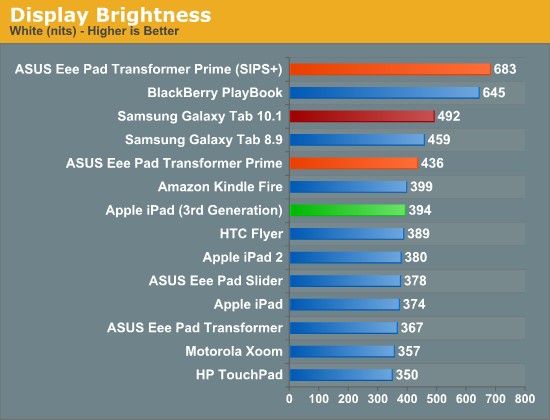
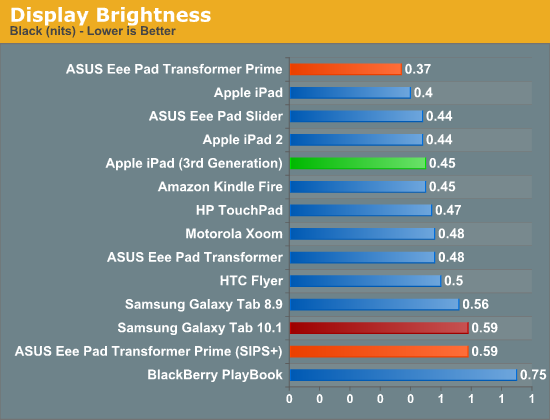
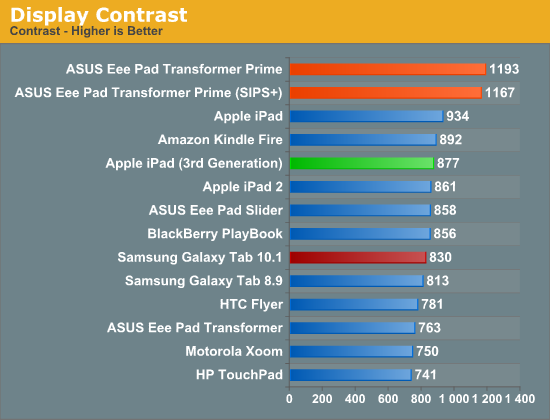
However once you start looking at color quality and gamut, the Galaxy Tab falls in line with the old standard. Samsung delivers similar a similar color gamut percentage to the iPad 2’s display, but the coverage area is different as you can see in the gallery below.
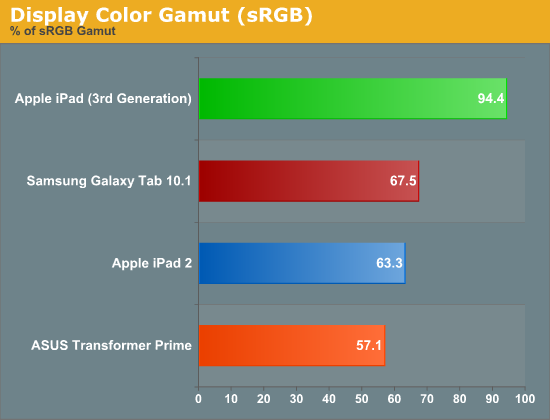
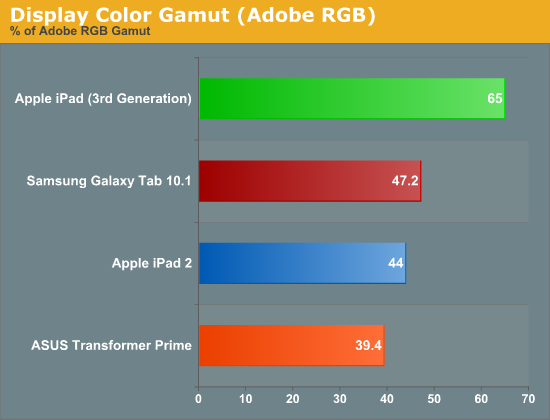
Both are short of the new iPad’s nearly full coverage of the sRGB space.
The delta E values echo what our CIE charts tell us, color and grayscale accuracy is simply better on the new iPad:
Note that ASUS’ TF Prime actually does better in the grayscale dE tests than the iPad. Apple may have raised the bar, but we’re still not anywhere close to perfection here.
Once again we have shots, taken at the same magnification, of the subpixel structure of all of these displays in order of increasing pixel density:
![]()
Apple iPad 2, 1024 x 768, 9.7-inches
![]()
ASUS Eee Pad Transformer Prime, 1280 x 800, 10.1-inches

Samsung Galaxy Tab 10.1, 1280 x 800, 10.1-inches
![]()
Apple iPad Retina Display (2012), 2048 x 1536, 9.7-inches
![]()
Apple iPhone 4S, 960 x 640, 3.5-inches
Performance
The Galaxy Tab 10.1 takes us back to a time when NVIDIA’s Tegra 2 was king. It was just a year ago that this was true. OMAP 4 was late, Tegra 3 was an eternity away and no one else had a dual-core Cortex A9 based SoC in shipping products. Unfortunately, by today’s standards, Tegra 2 is pretty slow. Not so much on the CPU side, but on the GPU side. Tegra 2 lacked the extra compute and efficiency improvements needed to really drive a 1280 x 800 display. Couple that with the bloat from Samsung’s TouchWiz update to Honeycomb and you don’t get a very smooth experience on the Galaxy Tab 10.1, especially compared to ASUS’ ICS enabled, Tegra 3 equipped Transformer Prime.
The GPU performance numbers support our subjective findings (more numbers here):
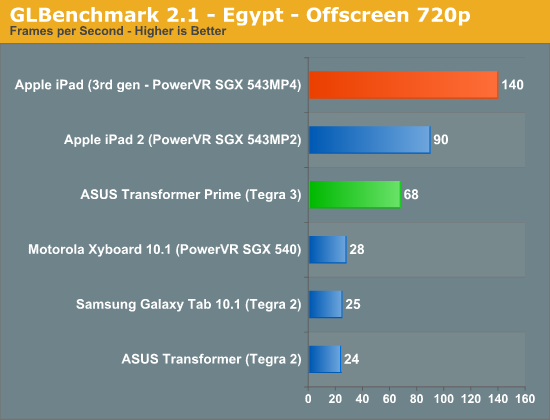
In our iPad review I talked about the gaming experience on Tegra 3 being pretty good using Tegra Zone titles. In fact, if a game is available for both iOS and Tegra Zone, the Tegra version typically looks better thanks to NVIDIA’s investment of additional developer resources for the title. Despite the visual gap, both platforms tend to offer good gaming experiences. The iOS app store is easier to navigate and compatibility with devices is less of a concern there, but developers on both sides of the fence try to deliver a ~30 fps experience regardless of platform. The Tegra 2 experience isn’t bad, but you do have to run games like GTA3 at lower quality settings to get similar frame rates to Tegra 3.
Battery Life
The iPad’s gigantic battery allowed it to last a bit longer on LTE than Motorola’s Xyboard 10.1, but what about compared to the Galaxy Tab 10.1? On LTE the Galaxy Tab 10.1 doesn’t fare as well as the Xyboard:
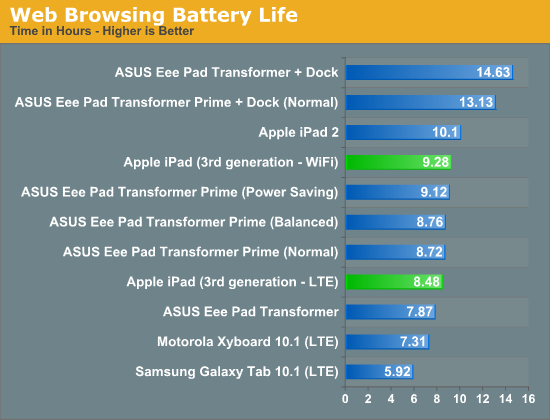
A few of you asked about video playback battery life of the new iPad. Using our old 720p, no-bframes test I managed 10.02 hours on the new iPad – tangibly less than the iPad 2 but above what Apple claims you should expect from the new tablet. I need to put together a 1080p, high profile video playback test now that more tablets can play higher quality streams. Perhaps I’ll do that in preparation for the TF700 review...
Final Words
Ask and you shall receive (time permitting). For those of you who asked, I hope the data shared here is what you were looking for. I've updated our original iPad review with all of this data as well. In short, the Galaxy Tab 10.1 LTE is a useful but not dramatically different comparison point from the Android camp. In the near term, ASUS' Transformer Pad Infinity is what I'm hoping will be some better competition.
On to the next one…


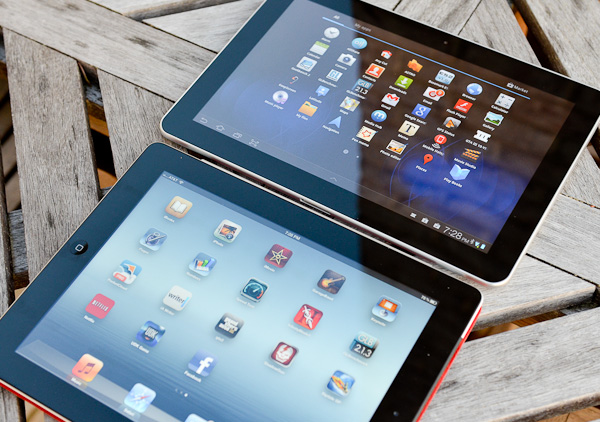






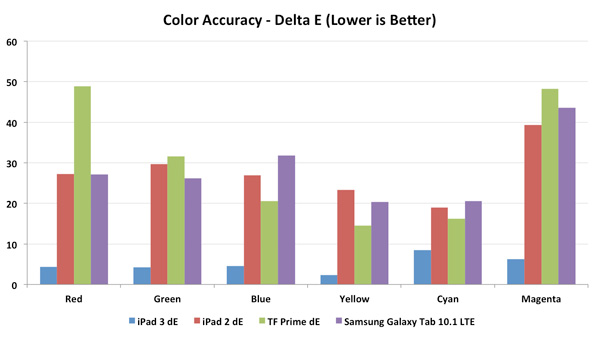

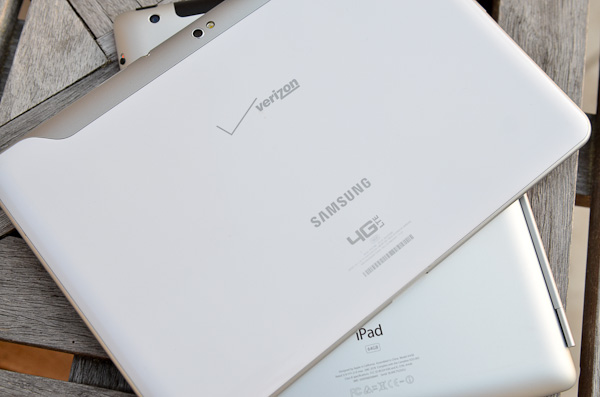








52 Comments
View All Comments
xype - Tuesday, April 3, 2012 - link
None. It’s just a simple way to find fault with the iPad 3 and the benchmarks. The fact that the iPad 2 already was more than a year ahead of every other tabler performance-wise doesn’t even enter into the picture.But, hey, Tegra 5, yada yada, next version of Android, yada, yada, announced-but-unreleased-Android-tablet, yada, yada, Android serious growth potential, yada, less space than a Nomad, blah blah, Apple is doomed. :P
vision33r - Tuesday, April 3, 2012 - link
That's the beauty of PVR deferred rendering technique.People failed to remember when Nvidia TNT2 vs PowerVR SG250 comparison on Anandtech here and how PowerVR still kept up high framerates in complex scenes with a lower powered GPU than Nvidia.
It doesn't matter the complexity of the game, it is only rendering visible scenes. It's a smarter technique.
With 3rd gen iPad games being shown such as Infinity Blade dungeon and upcoming UT4 engine on iPad. It is surpassing Xbox 360/PS3 in graphics.
If Apple announced a game controller SDK and peripherals support. It will wipe the floor of the Xbox and PS3 game market. It already has a sizeable cut in the casual gaming market.
Android is not even close because fragmentation, lack of standard Graphics API platform (Tegra is the exception), and Google is just terrible with setting standards and QC.
Steelbom - Tuesday, April 3, 2012 - link
That's unlikely, the XBox 360's GPU does 500m triangles a second, and the SGX543MP4 only roughly 180m. The iPad 3 however is running many games at near 2048x1536, whereas the 360 runs most at 1280x720. (Three times less pixels.)We'll start to see console quality games when the PowerVR 600 series GPUs are released... even one of the entry level models does 300m triangles a second, which is ten times that of the SGX543.
falcn - Tuesday, April 3, 2012 - link
Anand, could you please add to a future reviews a chart with white brightness in nits at minimum backlight level?It corresponds to how usable device is in the dark, for example checking email in bed with your spouse sleeping.
The last device I owned which was comfortable for reading in the dark was Nokia 770 Internet Tablet. It was almost on par with phosphorescent hands / dial found in wrist watches. Great contrast and not blinding. Some of the old UIQ smartphones was fine too in that regard. It was 6 years ago.
When LED became mainstream, things got ugly.
No display maker gives a shit anymore about mechanics of human sight, all that matters is the "Maximum brightness" and "The contrast ratio".
Contemporary devices tend to burn your eyes out in pitch-darkness. Neither iPad nor iPhone can't be used in the dark, they're too bright. You get temporary blind to environment and an eye strain from looking at the strong light source in the darkness.
Macbook Air is doing somewhat better thanks to software hack that reduce the amount of light the screen is producing by adding semi-transparent black layer.
http://itunes.apple.com/us/app/dimmer-than-dim/id4...
But the result is light years away from true, hardware-based low backlight level. The hack is just reducing contrast by making white closer to black, but it doesn't make "black" pixels any better, they are still emitting light. The dimmer the picture, the less contrast you have left.
To sum up the above, minimum backlight level in nits will make great addition to any mobile screen review.
medi01 - Tuesday, April 3, 2012 - link
1) It's a comparison to Galaxy Tab, yet it is never highlighted on charts?2) Can you explain huge difference in color gamut results between you and Tom?
Adobe RGB 1998
iPad2 49.9%
iPad3 66%
Galaxy Tab 62.8%
Transformer Prime 40.2%
http://www.tomshardware.com/reviews/ipad-3-benchma...
Anand Lal Shimpi - Wednesday, April 4, 2012 - link
1) Heard loud and clear, let me do something about that :)2) Not sure how THG is measuring, our results seem in line with what others have posted though - http://www.displaymate.com/Tablet_ShootOut_2.htm
Take care,
Anand
melgross - Tuesday, April 3, 2012 - link
It's too bad that the favorite tablet on the site isn't selling. It's hardly useful to have a decent tablet out if no one is buying it. Perhaps it's really true that a tablet, other than an iPad (which was considered to be pretty cheap when it came out), can't sell unless it's cheap.What does that do to these tablets mentioned here?
adityarjun - Tuesday, April 3, 2012 - link
Hoping to see the HTC One X reviewed in detailed soon. Please tell me it is in the pipeline. And hopefully the HTC One S too.Also looking forward to reading about the usability of the Ipad for general purposes in real life as well as an educational tool.
Death666Angel - Tuesday, April 3, 2012 - link
Hey!Considering this is supposed to be a comparison, could you highlight both tablets? I have a hard time looking at the graphs and differentiating between the other tablets. :-)
Thanks!
vol7ron - Tuesday, April 3, 2012 - link
Does it seem odd that the TF-P is more accurate in brightness, contrast, and greyscale delta, but so far off from everything in color accuracy?I'm curious how the accuracy ratings are as they approach the ends of the spectrum (e.g. those off colors like pink and greyish mixes), perhaps it would win in accuracy for those ranges?